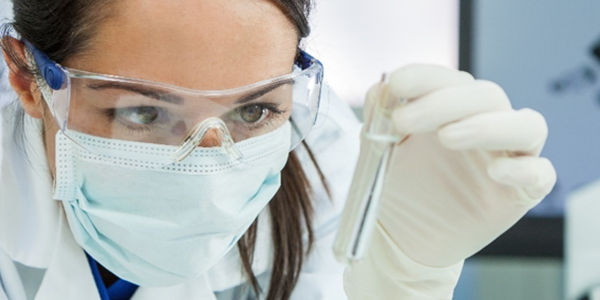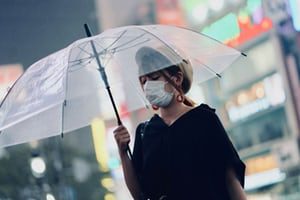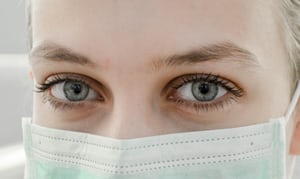1:30min

The article below is from 31 January 2020.
FOR UPDATED INFO PLEASE CHECK THE DEDICATED “CORONAVIRUS (COVID-19)” SECTION
By optometrists Audrey Molloy from Optometry NSW/ACT, Ben Hamlyn from Optometry Australia and Optometry Australia journalist Helen Carter
Optometrists are being urged to take proactive steps to prevent the spread of Coronavirus by routinely asking all patients before their appointment and again on arrival at the practice if they have returned from China in the past two weeks.
Based on advice from health authorities in Australia and overseas, Optometry Australia advises that the best risk averse option for optometrists and optometry practices is for optometrists to ask if a patient has returned from an affected area in China, or has returned from China with symptoms of fever, cough, sore throat or breathing difficulties.
If they answer yes to either of these questions, it is safest NOT to see non-urgent patients until after the incubation period of two weeks has passed.
15 minutes close contact
As of today, January 31, nine people have been diagnosed in Australia – in Sydney, Melbourne and the Gold Coast. More than 9,600 cases have been confirmed in at least 18 countries, mainly China, and at least 213 deaths have been confirmed, although many more people may be infected and not showing symptoms yet.
It’s also been revealed that the virus may only take 15 minutes to pass from one person to another as, according to NSW Health advice, people are now at risk of catching the virus if they spend a quarter of an hour in close contact, such as a face-to-face conversation, or two hours in the same confined space with an infected person.
Overnight the World Health Organisation declared the outbreak a global health emergency. It is only the sixth time the WHO has declared an international emergency of this kind.
What is Novel Coronavirus 2019-nCoV?
Coronaviruses are not new – they were first identified 60 years ago. They are more common in animals but can also infect humans. The name ‘coronavirus’ refers to the shape of the virus, which is round with a fringe of surface proteins creating a crown-like appearance.
Known coronaviruses can infect humans mildly (as in the common cold) or severely (as in SARS and MERS).
Fever, coughing, breathing difficulties
A new strain of coronavirus, novel coronavirus 2019-nCoV, broke out in December 2019 in Wuhan, in central China. This virus initially causes flu-like symptoms of fever, coughing, sore throat and breathing difficulties, but can lead to pneumonia and death.
An outbreak of a different coronavirus called SARS (or Severe Acute Respiratory Syndrome) in 2002-2003 in southern China infected about 8,000 people resulting in nearly 800 deaths. While 2019-nCoV is genetically close to the SARS coronavirus, it is not known yet if it is as severe.
How long before symptoms appear?
The incubation period is often longer than other viruses such as flu and can take 2-10 days to cause symptoms, although the virus remains contagious throughout this time. Thermal scans of passengers disembarking from flights are not reliable in picking up people infected by the virus, as they may not become ill until over a week later. The virus is believed to spread via human-to-human contact.
How is it treated?
Although there is no effective treatment or vaccination for 2019-nCoV at this stage, the strain of the virus has been isolated and replicated in laboratories to facilitate producing both a test and, ultimately, a vaccine for the disease.
If you develop a fever, cough, sore throat or shortness of breath within 14 days of travel to an affected area or have had contact with a person with confirmed coronavirus, you should immediately isolate yourself from other people. Contact your GP or your emergency department or call the healthdirect helpline 1800 022 222 and seek medical attention as soon as possible.
It is important to phone ahead so that the practice or emergency department can make appropriate preparations and protect others.
When seeking medical care wear a surgical mask (if available) otherwise ask for one when you arrive.

Photo, Unsplash, credit Tore F
Should I be at work?
If you or your family has recently visited any affected region in China or any other affected area, or has been in close contact with someone who has visited an affected area, do not return to work for two weeks to allow the incubation period to pass. Note: It is not possible to issue a ‘medical clearance certificate.’
If you become ill or feel unwell while travelling in China, you should not wait until you arrive back in Australia to seek medical assistance. Instead you should see a doctor or go to the local emergency department.
What should I do in my practice?
Take proactive steps to prevent spread of 2019 nCoV by routinely asking all patients in advance of their appointment and again on arrival at your practice:
- Have you returned from China in the past two weeks?
If yes, it is safest NOT to see non-urgent patients until after the incubation period (two weeks) has passed.
If you have recently returned from China, do you have any symptoms of fever, cough, sore throat or difficulty breathing?
If yes, do NOT see non-urgent patients until symptoms are resolved and the patient has been cleared by their doctor. Urgent patients will require consideration.
If you DO see a patient who has returned from China within the past two weeks OR any patient with the symptoms of a respiratory infection (cough, breathing difficulty, sore throat or fever etc), even if they have not been to China recently, the following protocols (based on what is known about SARS) are recommended by The Centre for Disease Control in the US:
- Where possible, provide patients with a surgical mask as soon as they are identified.
- Conduct their evaluation in a private room with the door closed.
- Provide a face mask for all personnel entering the room or dealing with the patient.
- Implement basic infection control measures including hand hygiene, respiratory hygiene/cough etiquette (regular hand washing, covering mouth and nose when coughing and sneezing), and environmental disinfection.
- Disinfect all surfaces they have come in contact with, including door handles and frames, equipment, chin rests, chair etc as per other virulent diseases (such as viral conjunctivitis).
- 70% Isopropyl alcohol is the most effective surface disinfection agent. Alcohol wipes can be used to wipe down equipment etc.
- Alcohol hand wash and wipes are usually available from pharmacies but may be out of stock. 99% isopropyl alcohol spray for disinfecting surfaces is available from hardware stores and office supplies stores. 70% isopropyl alcohol wipes are also available from office supplies stores.
- For medical devices in contact with a mucosal surface (eg tonometers, gonio prisms) a new chlorine dioxide disinfectant (Tristel wipes) has emerged as a good option for optometrists to consider using as it has TGA approval for high level disinfection of instrument grade surfaces in line with the ASNZ 4187 Australian Standard.

Photo, Unsplash, credit Ani Kolleshi.
The Australian Health Protection Principal Committee (AHPPC) is aware of:
- very recent cases of novel coronavirus which are asymptomatic or minimally symptomatic, and
- reports of one case of probable transmission from a pre-symptomatic case to other people, two days before onset of symptoms.
These data are limited and preliminary and AHPPC still believes that most infections are transmitted by people with symptomatic disease but we should take a highly precautionary approach so is making the following new recommendations:
- People who have been in contact with any confirmed novel coronavirus cases must be isolated in their home for 14 days following exposure;
- Returned travellers who have been in Hubei Province of China must be isolated in their home for 14 days after leaving Hubei Province, other than for seeking individual medical care.
Given the lower number of cases in China reported outside Hubei province, AHPPC does not currently recommend self-isolation for travellers from other parts of China or other countries. It is closely monitoring development of cases outside Hubei province and will update advice if necessary.
Stay up to date
Different state health departments may have slightly differing advice.
Check in with the Australian Health Department:
NSW: https://www.health.nsw.gov.au/Infectious/alerts/Pages/coronavirus-faqs.aspx and https://www.health.nsw.gov.au/Infectious/factsheets/Pages/novel-coronavirus.aspx
Queensland: http://conditions.health.qld.gov.au/HealthCondition/condition/14/217/838/novel-coronavirus
Victoria: https://www.dhhs.vic.gov.au/information-public-novel-coronavirus
WA: https://ww2.health.wa.gov.au/Articles/A_E/Coronavirus
Tasmania: https://www.dhhs.tas.gov.au/news/2020/coronavirus_update
Northern Territory: https://health.nt.gov.au/news/coronavirus
Call the Public Health Information Hotline in the event of a health emergency or incident affecting the public – 1800 004 599
ALSO see:
RACGP’s Information on Coronavirus
The Centre for Disease Control (CDC) in the US: https://www.cdc.gov/coronavirus/2019-ncov/about/index.html.
The World Health Organisation: https://www.who.int/csr/don/12-january-2020-novel-coronavirus-china/en/
Refresh your knowledge of infection control protocols with Optometry Australia’s guidelines for infection control. https://onlinelibrary.wiley.com/doi/full/10.1111/cxo.12544
Tagged as: Patient management